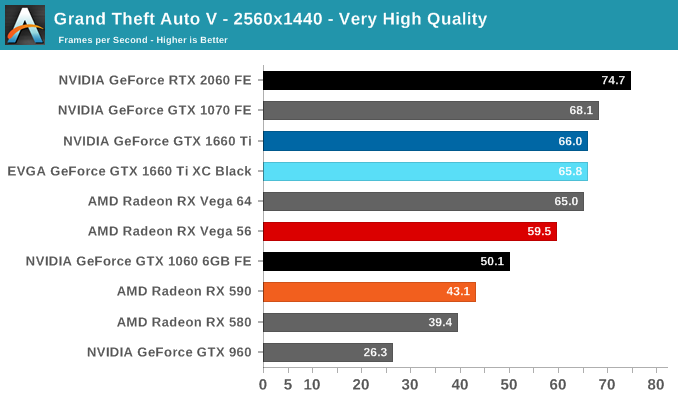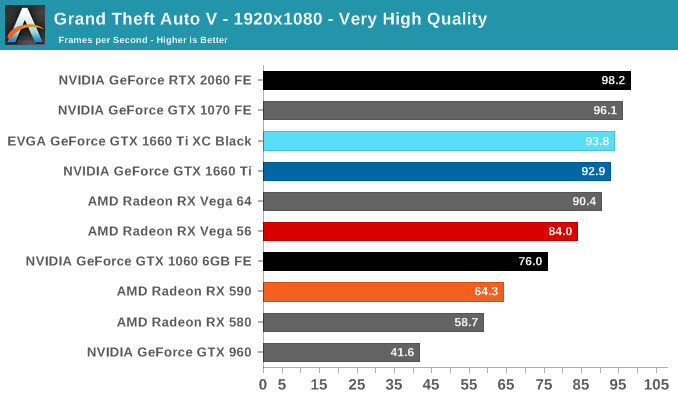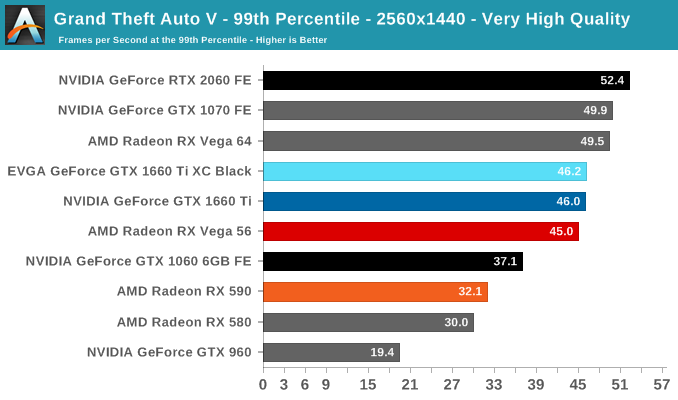The NVIDIA GeForce GTX 1660 Ti Review, Feat. EVGA XC GAMING: Turing Sheds RTX for the Mainstream Market
by Ryan Smith & Nate Oh on February 22, 2019 9:00 AM ESTGrand Theft Auto V (DX11)
Now a truly venerable title, GTA V is a veteran of past game suites that is still graphically demanding as they come. As an older DX11 title, it provides a glimpse into the graphically intensive games of yesteryear that don't incorporate the latest features. Originally released for consoles in 2013, the PC port came with a slew of graphical enhancements and options. Just as importantly, GTA V includes a rather intensive and informative built-in benchmark, somewhat uncommon in open-world games.
The settings are identical to its previous appearances, which are custom as GTA V does not have presets. To recap, a "Very High" quality is used, where all primary graphics settings turned up to their highest setting, except grass, which is at its own very high setting. Meanwhile 4x MSAA is enabled for direct views and reflections. This setting also involves turning on some of the advanced rendering features - the game's long shadows, high resolution shadows, and high definition flight streaming - but not increasing the view distance any further.
We've updated some of the benchmark automation and data processing steps, so results may vary at the 1080p mark compared to previous data.




For the GTX 1660 Ti, it's becoming clear that it is beyond firmly faster than the RX 590, its nominal competition at the $279 price point. The card pips the RX Vega 64, putting it in the realm of 1.4X to 1.5X faster than the RX 590, and around 10% faster than the RX Vega 56.
There's no mincing words here; while NVIDIA hardware may run better on GTA V in general, the size of GTX 1660 Ti's lead over the RX 590 is just crushing for the same MSRP, and equally so against the generally pricier RX Vega 56.











157 Comments
View All Comments
Rudde - Friday, February 22, 2019 - link
Never mind, the second page explains this well. (Parallell execution of fp16, fp32 and int32)CiccioB - Saturday, February 23, 2019 - link
Not only that.With Turing you also get mesh shading and a better support for thread switching, which is a awful technique used on GCN to improve its terrible efficiency, having lots of "bubbles" in the pipelines.
That's the reason you see previous AMD optimized games that didn't run too well with Pascal work much better with Turing, as the high threaded technique (the famous AC which is a bit overused in engines created for the console HW) is not going to constantly stall the SM with useless work as that of frequent task switching.
AciMars - Saturday, February 23, 2019 - link
“Worse yet, the space used per SM has gotten worse“. not true.. you know, turing have separate cuda cores for int and fp. It means when turing have 1536 cuda cores means 1536 int + 1536 fp cores. So on die size actually turing have 2x cuda cores compare to pascalCiccioB - Monday, February 25, 2019 - link
Not exactly, the number of CUDA core are the same, just that a new independent ALU as been added.A CUDA core is not only an execution unit, it also registers, memory (cache), buses (memory access) and other special execution units (load/store).
By adding a new integer ALU you don't automatically get double the capacity as really doubling the number of a complete CUDA core.
ballsystemlord - Friday, February 22, 2019 - link
Here are some spelling and grammar corrections.This has proven to be one of NVIDIA's bigger advantages over AMD, an continues to allow them to get away with less memory bandwidth than we'd otherwise expect some of their GPUs to need.
Missing d as in "and":
This has proven to be one of NVIDIA's bigger advantages over AMD, and continues to allow them to get away with less memory bandwidth than we'd otherwise expect some of their GPUs to need.
so we've only seen a handful of games implement (such as Wolfenstein II) implement it thus far.
Double implement, 1 befor ()s and 1 after:
so we've only seen a handful of games (such as Wolfenstein II) implement it thus far.
For our games, these results is actually the closest the RX 590 can get to the GTX 1660 Ti,
Use "are" not "is":
For our games, these results are actually the closest the RX 590 can get to the GTX 1660 Ti,
This test offers a slew of additional tests - many of which use behind the scenes or in our earlier architectural analysis - but for now we'll stick to simple pixel and texel fillrates.
Missing "we" (I suspect that the sentence should be reconstructed without the "-"s, but I'm not that good.):
This test offers a slew of additional tests - many of which we use behind the scenes or in our earlier architectural analysis - but for now we'll stick to simple pixel and texel fillrates.
"Looking at temperatures, there are no big surprises here. EVGA seems to have tuned their card for cooling, and as a result the large, 2.75-slot card reports some of the lowest numbers in our charts, including a 67C under FurMark when the card is capped at the reference spec GTX 1660 Ti's 120W limit."
I think this could be clarified as their are 2 EVGA cards in the charts and the one at 67C is not explicitly labeled as EVGA.
Thanks
Ryan Smith - Saturday, February 23, 2019 - link
Thanks!boozed - Friday, February 22, 2019 - link
The model numbers have become quite confusingYojimbo - Saturday, February 23, 2019 - link
I don't think they are confusing, 16 is between 10 and 20, plus the RTX is extra differentiation. In fact if NVIDIA had some cards in the 20 series with RTX capability and some cards in 20 series without RTX capability, even if some were 'GTX' and some were 'RTX', then that would be far more confusing. Putting the non-RTX Turing cards in their own series is a way of avoiding confusion. But if they actually come out with an "1180" as say some rumors floating around, that would be very confusing.haukionkannel - Saturday, February 23, 2019 - link
Interesting to see the next year.Rtx 3050 and gtx 2650ti for the weaker version, if we get one new card rtx family... Hmm... that could work if They keep the naming. 2021 RTX3040 and gtx 2640ti...
CiccioB - Thursday, February 28, 2019 - link
Next generation all cards will have enough RT and tensor core enabled.